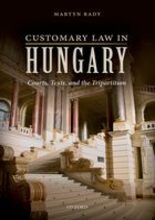and Balkan Europe
by IECOB & AIS Università di Bologna

This area collects information about a wide range of books, monographies and edited volumes concerning the countries and themes relevant to PECOB
Customary Law in Hungary
Courts, Texts, and the Tripartitum
by: Martyn Rady
published by: Oxford University Press
pp: 288
ISBN: 978-0-19-874391-0
price: £60.00

This is the first comprehensive treatment in any language of the history of customary law in Hungary, from the thirteenth to the twentieth centuries. Hungary's customary law was described by Stephen Werboczy in 1517 in the extensive law code known as the Tripartitum. As Werboczy explained, Hungarian law derived from the interplay of Romano-canonical law, statute, written instruments, and court judgments. It was also responsive, however, to popular conceptions of the law's content and application, as communicated through the lay membership of the kingdom's courts. Publication of the Tripartitum was intended to make the law more certain by fixing it in writing. Nevertheless, its text was customized by actual use, in the same way as the statute laws of the kingdom were adjusted as a consequence of court practice and of errors in their transmission.
The reputation attaching to the Tripartitum and Hungary's insulation from the Roman Law Reception meant that the Tripartitum continued to retain authority until well into the nineteenth century. Attempts to replace it foundered and it was the principal text on which the courts and the schools relied, not only in Habsburg Hungary but also in Transylvania. Courts, nevertheless, continued to modify its provisions in the interests of rendering judgments that they deemed either to be right or in conformity with developing practices. Even after the establishment of a parliamentary form of government in the nineteenth century, a strong customary element attached to Hungarian law, which was amplified by the association of customary law with national traditions. The consequence was that Hungary maintained aspects of a customary law regime until the Communist period.
Readership: Legal historians, and students and scholars of Hungarian and Central European history
Table of contents
1: The Legal Landscape
2: Customary Law and the Tripartitum
3: Customary Law, Legislation, and Letters
4: Customary Law and Medieval Courts
5: King and Nobility
6: The Nobleman and His Land
7: Crime and Prosecution
8: Medieval Procedure and Judicial Decision Making
9: Early Modern Legal Institutions
10: Codification after the Tripartitum
11: Courts and the Law in the Long Eighteenth Century
12: Custom and Law in the Modern Period
Conclusion: Customary Law in Hungary
About the Author
Martyn Rady, Professor of Central European History at the School of Slavonic and East European Studies, and General Editor of the Slavonic and East European Review, University College London
Martyn Rady has taught at the UCL School of Slavonic and East European Studies since 1990, where he is Professor of Central European History. He was a Leverhulme Trust research fellow in 2010-12 and he has an honorary doctorate from the Károli Gáspár University of the Reformed Church in Budapest. He was for ten years part of the team that edited and translated the corpus of the laws of medieval Hungary and is General Editor of the Slavonic and East European Review. His previous books include Medieval Buda (1985), and Nobility, Land and Service in Medieval Hungary (2000). He has also edited and translated several of the leading Hungarian and Czech medieval chronicles.








